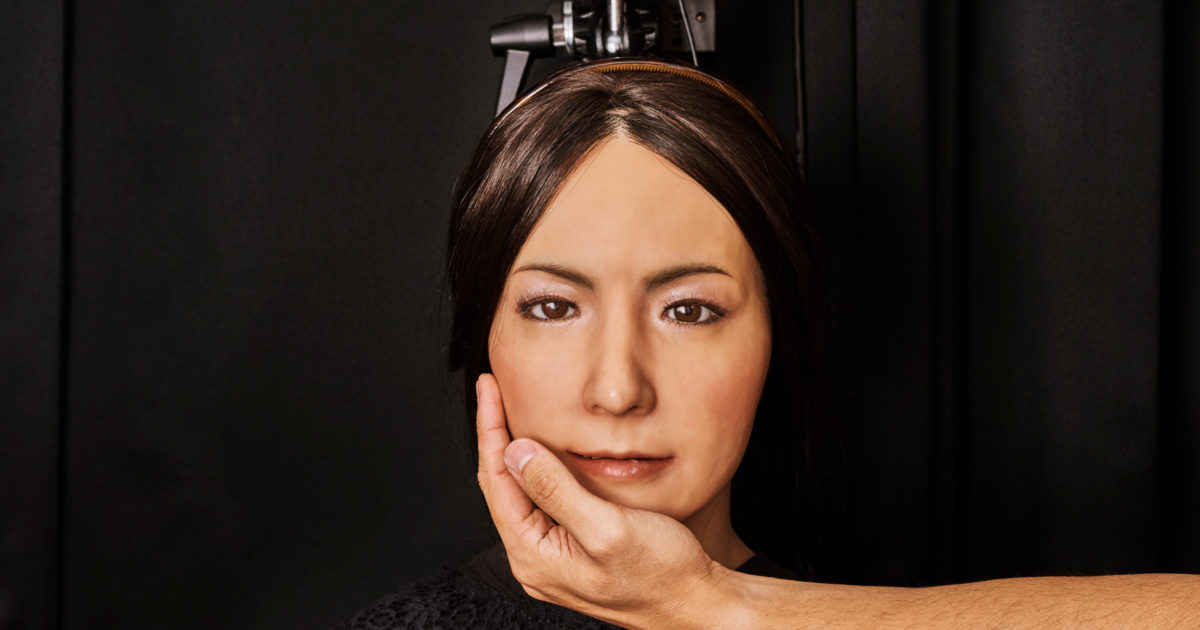IT IS SUMMER 2002, mid-morning in a university research lab on the edge of Osaka, Japan. Two girls—both dressed in pale yellow, with child-puffy cheeks, black shoulder-length hair, and bangs—stand opposite each other under fluorescent lights. More precisely: One is a girl, 5 years old; the other is her copy, her android replica. They are the same size, one modeled on the other, and they are meeting for the first time. ¶ The girl stares hard into the eyes of her counterpart; its expression is stern and stiff. It seems to return her gaze. ¶ A man is videotaping the pair—he is the father of one, creator of the other—and from off-camera he asks, “Would you like to say something?” ¶ The girl turns to him, disoriented. She turns back to the android. ¶ “Talk to her!” he says. “Hello.” ¶ The girl repeats the word, quietly, to her robot-self. It nods. ¶ Her father feeds her another line: “Let’s play.”
The android wiggles its head. Her father chuckles behind the camera. But the girl does not budge. She simply stares at her double, the look on her face one of focus and perhaps concern.
Each member of this pair continues making the barely there gestures that serve, through reflex or ruse, as signs of life: Each blinks at regular intervals; each tilts her head from side to side. One is processing, in the raw, sensory-overload manner of a human child; the other is performing a series of simple movements made possible by the servomotors installed inside the silicone casing that is its skin.
“Is it difficult to play with her?” the father asks. His daughter looks to him, then back at the android. Its mouth begins to open and close slightly, like a dying fish. He laughs. “Is she eating something?”
The girl does not respond. She is patient and obedient and listens closely. But something inside is telling her to resist.
“Do you feel strange?” her father asks. Even he must admit that the robot is not entirely believable.
Eventually, after a few long minutes, the girl’s breathing grows heavier, and she announces, “I am so tired.” Then she bursts into tears.
That night, in a house in the suburbs, her father uploads the footage to his laptop for posterity. His name is Hiroshi Ishiguro, and he believes this is the first record of a modern-day android.
IN THE 15 YEARS since, Ishiguro has produced some 30 androids, most of them female. They have included replicas of a newscaster, an actress, and a fashion model. These androids have made numerous public appearances—in cafés and department stores, singing in malls, performing in a play. Mostly, though, Ishiguro’s brood of pretty “women” is used for his academic experiments, many of which are conducted at two locations in Japan: the Advanced Telecommunications Research Institute International in Nara and the Intelligent Robotics Laboratory on the campus of Osaka University.
The lab, known as IRL, is embedded within a maze of austere, gray university buildings. In one of these industrial boxes, about 30 students and assistant professors work in a series of near-silent computer pods and observation rooms. Teams of young men shuffle down the long, linoleum-lined hallways in sweatshirts, pace the research rooms in their socks, or hover over laptops in rows, heads down, subsisting mostly on Red Bull, crackers, and Pocky Sticks. (Women do not seem like a natural fit here. As if to underline this fact, a sign by the restrooms reads, “Watch out for male strangers in the ladies toilet.”)
Presiding over this disheveled scene is Ishiguro-sensei. He is immediately recognizable, looking just as he does in promotional photos from recent years: perfectly mod in slim-fitting black with matching leather backpack and fanny pack. He wears tinted hexagonal glasses and styles his jet-black hair into a mop top that swoops across his forehead. This is his department: Ishiguro, 54, is a distinguished professor at one of the country’s top universities, with two labs, partnerships with a dozen private companies throughout Japan, a recent $16 million grant from the government (one of its most generous in science and engineering, he says), and seven secretaries to manage it all.
Sourced through Scoop.it from: www.wired.com



Leave A Comment